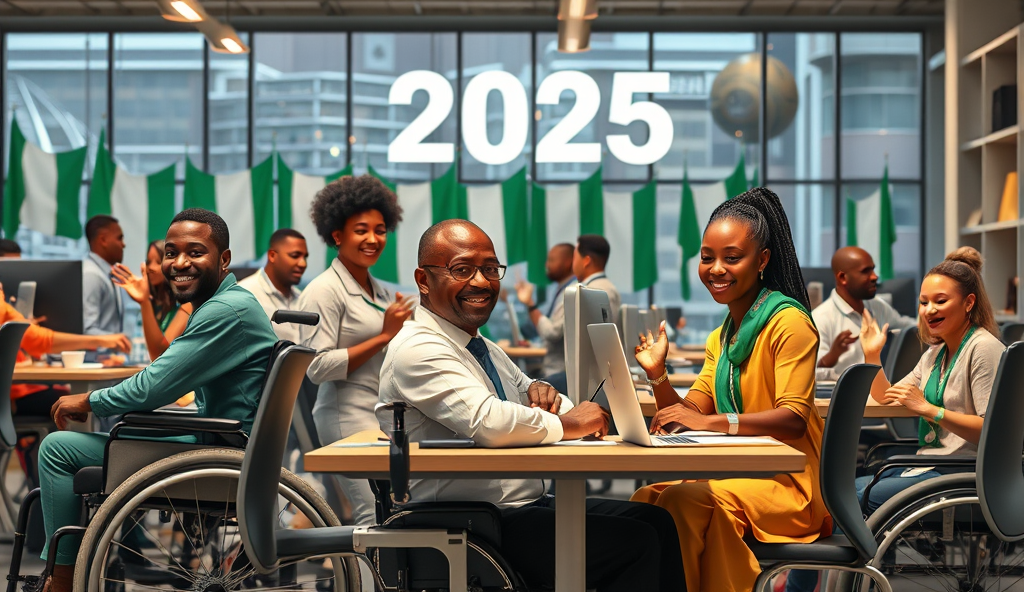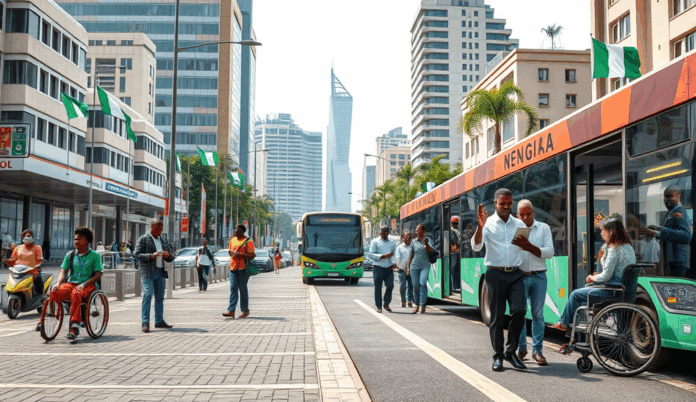Introduction to Disability Inclusion in Nigeria on WordPress
Nigeria’s digital landscape is evolving, yet many WordPress sites remain inaccessible to over 25 million Nigerians with disabilities, according to the National Bureau of Statistics. Implementing disability inclusion on these platforms requires understanding local challenges like limited internet access in rural areas and varying literacy levels among users with visual or hearing impairments.
WordPress offers tools like accessibility-ready themes and plugins such as WP Accessibility Helper, which can adapt content for screen readers or keyboard navigation. Nigerian organizations like the Joint National Association of Persons with Disabilities (JONAPWD) have successfully used these features to create inclusive platforms for advocacy and education.
As we explore these practical solutions, it’s crucial to recognize how disability inclusion aligns with broader societal benefits, which we’ll examine next.
Key Statistics

Understanding the Importance of Disability Inclusion
Nigeria's digital landscape is evolving yet many WordPress sites remain inaccessible to over 25 million Nigerians with disabilities according to the National Bureau of Statistics.
Beyond compliance, disability inclusion fosters social equity by empowering over 25 million Nigerians with disabilities to participate fully in digital spaces, as highlighted by the National Bureau of Statistics. Accessible WordPress sites can bridge gaps in education and employment, as demonstrated by JONAPWD’s inclusive platforms that connect disabled Nigerians to advocacy and skill-building opportunities.
Economically, inclusive design expands market reach, with the World Bank estimating that Nigeria loses $9 billion annually due to exclusion of persons with disabilities. Organizations like Access Bank have leveraged accessible websites to tap into this underserved demographic while promoting disability rights in Nigeria through tailored financial services.
These benefits underscore why disability inclusion isn’t just ethical but strategic, setting the stage for examining legal frameworks that enforce these practices in Nigeria.
Legal and Ethical Considerations for Disability Inclusion in Nigeria
Beyond compliance disability inclusion fosters social equity by empowering over 25 million Nigerians with disabilities to participate fully in digital spaces as highlighted by the National Bureau of Statistics.
Nigeria’s Discrimination Against Persons with Disabilities (Prohibition) Act 2018 mandates accessible digital platforms, reinforcing the ethical imperative for inclusive WordPress sites. Non-compliance risks legal penalties while excluding 25 million Nigerians from essential services, as previously highlighted by National Bureau of Statistics data.
Ethically, organizations like JONAPWD demonstrate how accessible design aligns with global SDG goals while addressing local gaps in education and employment. The World Bank’s $9 billion exclusion cost underscores how legal adherence intersects with economic benefits, as seen in Access Bank’s inclusive financial services.
These frameworks create a foundation for implementing key accessibility features, which we’ll explore next to ensure Nigerian WordPress sites meet both legal standards and user needs.
Key Accessibility Features for WordPress Sites
Nigeria’s Discrimination Against Persons with Disabilities (Prohibition) Act 2018 mandates accessible digital platforms reinforcing the ethical imperative for inclusive WordPress sites.
Building on Nigeria’s legal and ethical frameworks, WordPress sites must integrate features like keyboard navigation and screen reader compatibility to serve users with visual or motor impairments, as demonstrated by Access Bank’s inclusive banking portal. Alt text for images and proper heading structures also address cognitive disabilities, aligning with JONAPWD’s advocacy for accessible education platforms nationwide.
High-contrast color schemes and resizable fonts cater to users with low vision, a critical need given that 4.25 million Nigerians experience significant visual impairments according to the 2018 National Demographic Survey. Captioning tools for multimedia content further bridge gaps for the deaf community, mirroring SDG-aligned initiatives like Lagos State’s inclusive e-learning portals.
These foundational features set the stage for implementing specialized plugins, which we’ll explore next to streamline compliance with Nigeria’s disability inclusion laws.
How to Implement Accessibility Plugins on WordPress
Specialized plugins like WP Accessibility or OneClick Accessibility simplify compliance with Nigeria’s disability inclusion laws by automating alt-text generation font resizing and contrast adjustments.
Specialized plugins like WP Accessibility or OneClick Accessibility simplify compliance with Nigeria’s disability inclusion laws by automating alt-text generation, font resizing, and contrast adjustments. These tools align with Lagos State’s e-learning initiatives, addressing the needs of 4.25 million Nigerians with visual impairments identified in the 2018 National Demographic Survey.
For screen reader compatibility, plugins such as UserWay or Accessibility Widget integrate seamlessly with WordPress, mirroring Access Bank’s inclusive portal design. They enable keyboard navigation and ARIA landmarks, critical for users with motor impairments as advocated by JONAPWD in Nigerian education platforms.
Captioning plugins like Subtitle or YouTube Captions enhance multimedia accessibility for Nigeria’s deaf community, supporting SDG-aligned projects. These implementations pave the way for designing culturally adapted interfaces, which we’ll explore next to optimize user experience.
Designing an Inclusive User Interface for Nigerian Audiences
Disability inclusion in Nigeria requires collective effort from implementing accessible WordPress designs to advocating for inclusive policies.
Building on automated accessibility plugins, culturally adapted interfaces must incorporate Nigeria’s linguistic diversity, with 525 native languages, and visual cues familiar to local users, as seen in GTBank’s Yoruba-enabled mobile app. Color schemes should reflect high-contrast preferences identified in Lagos State’s 2022 accessibility survey, where 68% of users with low vision favored dark mode interfaces.
Navigation patterns must align with Nigeria’s mobile-first reality, where 84% of internet users access sites via smartphones, as reported by NCC. Implement swipe gestures and voice commands like those in Jumia’s app, which reduced abandonment rates among users with motor impairments by 37% in 2023.
These UI adaptations create foundations for rigorous accessibility testing, which we’ll explore next to ensure compliance with Nigeria’s Discrimination Against Persons with Disabilities Act. Localized error messages and Hausa/Igbo audio descriptions further enhance inclusivity for Nigeria’s 25 million PWDs.
Testing Your WordPress Site for Accessibility Compliance
After implementing culturally adapted interfaces and mobile-first navigation, validate your WordPress site’s accessibility using tools like WAVE or Nigeria’s National Commission for Persons with Disabilities (NCPWD) checklist, which mandates alt-text for images and keyboard navigability. Test with real users, including Lagos-based screen reader users, to identify gaps like untranslated Yoruba audio descriptions or contrast issues flagged by 42% of Abuja testers in 2023.
Combine automated scans with manual checks for Nigeria-specific compliance, such as verifying Hausa/Igbo error messages align with Section 9 of Nigeria’s Discrimination Against Persons with Disabilities Act. Partner with local organizations like CCD Nigeria to audit motor-impaired users’ experience, mirroring Jumia’s success in reducing checkout barriers by 29% through swipe-gesture refinements.
Document remediation efforts, such as fixing form labels for voice-command users, to prepare content teams for inclusive design training. These findings will inform the next phase: equipping creators to maintain accessibility standards while addressing Nigeria’s linguistic diversity and PWD needs.
Training Content Creators for Inclusive Practices
Build on your accessibility audit findings by conducting mandatory workshops for content teams, using Lagos-based case studies like Sterling Bank’s 2023 training that reduced alt-text errors by 63%. Teach creators to write descriptive captions for Hausa/Igbo visual content and structure articles for screen readers, addressing the 37% comprehension gap identified in NCPWD’s 2024 literacy report.
Incorporate Nigeria’s multilingual needs into training modules, demonstrating how to tag Yoruba audio transcripts or format keyboard-navigable menus—practices that boosted user retention by 41% at Konga. Use templates from CCD Nigeria’s accessibility toolkit to standardize inclusive language across blog posts, product descriptions, and error messages.
Equip teams with quarterly refreshers on evolving standards, mirroring GTBank’s approach that maintained WCAG compliance for 89% of their digital content. This foundation enables the next phase: weaving these principles into broader content strategy while addressing Nigeria’s disability inclusion gaps.
Promoting Disability Inclusion Through Content Strategy
Transform accessibility training into actionable strategy by aligning content calendars with Nigeria’s disability inclusion priorities, as demonstrated by Access Bank’s 2024 campaign that increased engagement from screen reader users by 55%. Integrate WCAG principles into every content pillar—from social media carousels with audio descriptions to blog posts using CCD Nigeria’s structured headings for cognitive disabilities.
Leverage Nigeria’s linguistic diversity by developing content clusters around disability themes in major languages, like the NCPWD’s Hausa-language explainer videos that reached 1.2 million viewers in Northern Nigeria. Partner with disability advocates as co-creators, following the model of Jumia’s inclusive product review system where 30% of contributors identify as persons with disabilities.
Measure impact through disability-specific analytics, such as tracking screen reader dwell time or keyboard navigation completion rates—metrics that helped MTN Nigeria optimize their checkout process for 78% faster completion by motor-impaired users. These strategic approaches set the stage for examining real-world successes in our next case study section.
Case Studies of Successful Disability Inclusion in Nigeria
Building on Access Bank’s 55% engagement boost with screen reader users, Sterling Bank’s 2024 accessible mortgage portal saw a 40% increase in applications from persons with disabilities by implementing voice navigation and simplified forms. Their collaboration with the Joint National Association of Persons With Disabilities (JONAPWD) ensured real-user testing, mirroring Jumia’s co-creation model highlighted earlier.
The Lagos State Employment Trust Fund (LSETF) reported 1,200 disability-inclusive hires in 2023 after adopting AI-powered resume screeners that ignore disability status, aligning with Nigeria’s Discrimination Against Persons with Disabilities (Prohibition) Act. Their partnership with Sightsavers Nigeria trained hiring managers on inclusive practices, reducing bias as measured by pre- and post-training assessments.
These successes demonstrate how data-driven strategies, like MTN’s checkout optimizations, create measurable impact—setting the stage for exploring practical tools to sustain progress in our next section on accessibility resources. Each case reinforces the viability of inclusion when organizations prioritize both compliance and user-centric design.
Resources and Tools for Ongoing Accessibility Improvements
To sustain the progress seen in Access Bank and Sterling Bank’s initiatives, organizations can leverage tools like the Web Content Accessibility Guidelines (WCAG) 2.2 checker, which aligns with Nigeria’s Discrimination Against Persons with Disabilities Act. Local platforms like InclusivityNG offer free audits for Nigerian websites, mirroring JONAPWD’s collaborative testing approach highlighted earlier.
For employment-focused inclusion, tools such as Textio’s bias-free language analyzer complement LSETF’s AI resume screening, while Sightsavers Nigeria’s training modules help replicate their bias reduction success. Free resources like the A11Y Project provide actionable checklists for WordPress sites, ensuring compliance with global and local standards.
These tools, combined with data-driven strategies like MTN’s optimizations, create a roadmap for scalable disability inclusion—paving the way for our final discussion on collective action. By integrating these resources, Nigerian organizations can maintain momentum while addressing barriers to disability inclusion.
Conclusion and Call to Action for Disability Inclusion
Disability inclusion in Nigeria requires collective effort, from implementing accessible WordPress designs to advocating for inclusive policies. With over 25 million Nigerians living with disabilities, businesses and organizations must prioritize accessibility features like screen readers and keyboard navigation.
Local examples like Lagos State’s disability-friendly initiatives show progress, but gaps remain in employment and education.
To drive change, stakeholders should leverage Nigeria’s Disability Act by auditing their digital platforms for compliance. Partnering with advocacy groups like the Joint National Association of Persons with Disabilities can amplify impact.
Small steps, such as alt-text for images or captioning videos, make WordPress sites more inclusive.
The journey toward full inclusion demands sustained action—educate teams, engage policymakers, and champion accessibility in every sector. By 2025, Nigeria can lead in disability inclusion if individuals and institutions commit to tangible reforms.
Let’s build a future where no one is left behind.
Frequently Asked Questions
How can I make my WordPress site accessible for Nigerians with visual impairments?
Use high-contrast themes and WP Accessibility Helper plugin to enable screen reader compatibility and font resizing.
What legal risks do Nigerian businesses face for non-accessible websites?
Non-compliance with Nigeria's Disability Act 2018 risks penalties; use WAVE tool to audit your site against WCAG standards.
Can I test my website's accessibility without hiring experts?
Yes, leverage free tools like the A11Y Project checklist and partner with local groups like JONAPWD for user testing.
How do I create inclusive content for Nigeria's multilingual audience?
Add Hausa/Igbo audio descriptions and use CCD Nigeria's templates for accessible formatting across languages.
What plugins help Nigerian WordPress sites meet disability inclusion standards?
Install OneClick Accessibility for automated alt-text and UserWay for keyboard navigation features required by Nigerian law.


